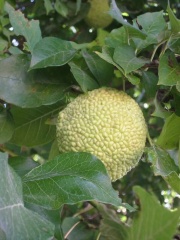Difference between revisions of "Osage orange"
m (Text replace - "== Authority ==" to "== Sources Checked for Data in Record ==") |
|||
| (One intermediate revision by one other user not shown) | |||
| Line 4: | Line 4: | ||
== Description == | == Description == | ||
| − | A golden color dye extracted from the wood of the Osage orange tree, ''Maclura pomifera'' (formerly ''Toxylon pomiferum''), indigenous to the southwestern parts of the United States. Used by Native Americans, the extract produces a clear gold colorant primarily composed of [ | + | A golden color dye extracted from the wood of the Osage orange tree, ''Maclura pomifera'' (formerly ''Toxylon pomiferum''), indigenous to the southwestern parts of the United States. Used by Native Americans, the extract produces a clear gold colorant primarily composed of [[morin|morin]]. On [[wool|wool]], it produces a golden color with a chrome mordant and a yellow-tan color with an alum mordant. Osage orange dye has good color fastness. Osage oranges have also been used as a home remedy as a repellent for [[silverfish|silverfish]], [[cockroach|cockroaches]], [[spider|spiders]], crickets, and fleas. |
== Synonyms and Related Terms == | == Synonyms and Related Terms == | ||
| Line 10: | Line 10: | ||
Maclura pomifera; Toxylon pomiferum; hedge apple; horse apple; hedge ball; bodark; bois d'arc; bow wood; Natural Yellow 8; CI 75660; monkeybrain; Maclura (Deut.); oranger des Osages (Fr.); Osagedoorn (Ned.); Laranja-de-osage (Port.); | Maclura pomifera; Toxylon pomiferum; hedge apple; horse apple; hedge ball; bodark; bois d'arc; bow wood; Natural Yellow 8; CI 75660; monkeybrain; Maclura (Deut.); oranger des Osages (Fr.); Osagedoorn (Ned.); Laranja-de-osage (Port.); | ||
| − | == | + | == Risks == |
| − | + | Fruit is not toxic but will cause vomiting. | |
| − | == | + | == Physical and Chemical Properties == |
| − | Fruit | + | * Small tree growing to 15 m with irregular crown and stiff spiny branches. |
| + | * Bark = orange-brown with scaly ridges and irregular furrows. | ||
| + | * Leaf = alternate, simple, pinnately veined, 2-5 inches long with shiny top surface. | ||
| + | * Fruit = large, round, rough surfaced druped with citrus smell. | ||
| − | == | + | ==Resources and Citations== |
* Helmut Schweppe, Schweppe color collection index and information book | * Helmut Schweppe, Schweppe color collection index and information book | ||
| − | * ''Encyclopedia Britannica'', http://www.britannica.com Comment: "Osage orange" | + | * ''Encyclopedia Britannica'', http://www.britannica.com Comment: "Osage orange" [Accessed May 6, 2002]. |
* Colour Index International online at www.colour-index.org | * Colour Index International online at www.colour-index.org | ||
| Line 28: | Line 31: | ||
* J. Thornton, 'The Use of Dyes and Colored Varnishes in Wood Polychromy', ''Painted Wood: History and Conservation'', The Getty Conservation Insitute, Los Angeles, 1998 | * J. Thornton, 'The Use of Dyes and Colored Varnishes in Wood Polychromy', ''Painted Wood: History and Conservation'', The Getty Conservation Insitute, Los Angeles, 1998 | ||
| − | * Wikipedia | + | * Wikipedia: http://en.wikipedia.org/wiki/Osage_orange (Accessed Dec. 9, 2005) |
[[Category:Materials database]] | [[Category:Materials database]] | ||
Latest revision as of 14:58, 20 October 2022
Description
A golden color dye extracted from the wood of the Osage orange tree, Maclura pomifera (formerly Toxylon pomiferum), indigenous to the southwestern parts of the United States. Used by Native Americans, the extract produces a clear gold colorant primarily composed of Morin. On Wool, it produces a golden color with a chrome mordant and a yellow-tan color with an alum mordant. Osage orange dye has good color fastness. Osage oranges have also been used as a home remedy as a repellent for Silverfish, cockroaches, spiders, crickets, and fleas.
Synonyms and Related Terms
Maclura pomifera; Toxylon pomiferum; hedge apple; horse apple; hedge ball; bodark; bois d'arc; bow wood; Natural Yellow 8; CI 75660; monkeybrain; Maclura (Deut.); oranger des Osages (Fr.); Osagedoorn (Ned.); Laranja-de-osage (Port.);
Risks
Fruit is not toxic but will cause vomiting.
Physical and Chemical Properties
- Small tree growing to 15 m with irregular crown and stiff spiny branches.
- Bark = orange-brown with scaly ridges and irregular furrows.
- Leaf = alternate, simple, pinnately veined, 2-5 inches long with shiny top surface.
- Fruit = large, round, rough surfaced druped with citrus smell.
Resources and Citations
- Helmut Schweppe, Schweppe color collection index and information book
- Encyclopedia Britannica, http://www.britannica.com Comment: "Osage orange" [Accessed May 6, 2002].
- Colour Index International online at www.colour-index.org
- J. Thornton, 'The Use of Dyes and Colored Varnishes in Wood Polychromy', Painted Wood: History and Conservation, The Getty Conservation Insitute, Los Angeles, 1998
- Wikipedia: http://en.wikipedia.org/wiki/Osage_orange (Accessed Dec. 9, 2005)
